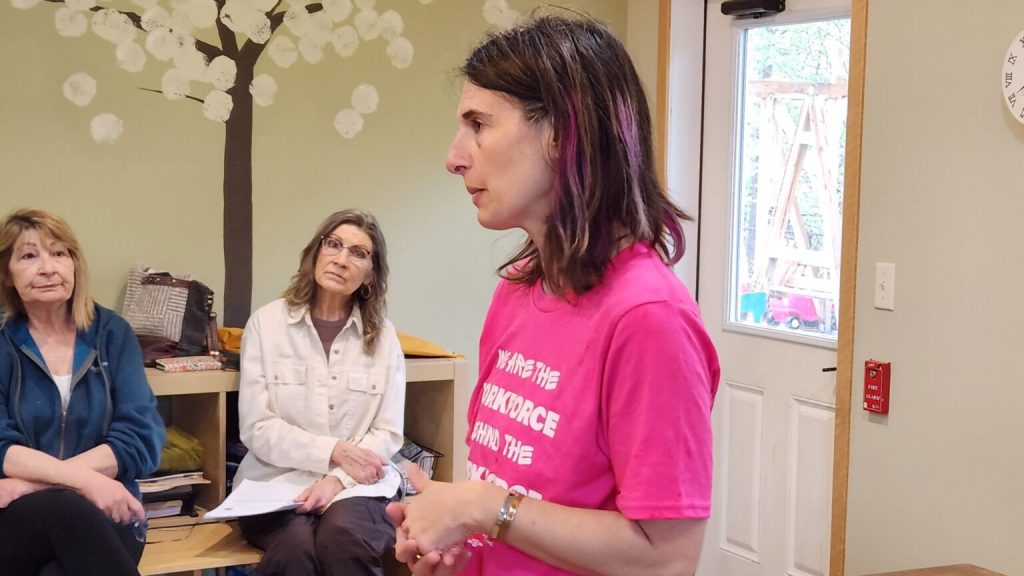Report Finds 25% of Childcare Providers Could Close Without State Support
New report from state agency bolsters Gov. Evers' case for $480 million childcare allocation.

In a new survey of Wisconsin child care providers, 25% said they could close without renewed state support. Corrine Hendrickson, shown here at a 2023 event to support the child care sector, said her New Glarus family care will likely have to raise fees. (Photo by Erik Gunn/Wisconsin Examiner)
One in four Wisconsin child care providers could close their doors if the state’s ongoing support isn’t replaced after it ends in June, according to a state-commissioned report released Thursday.
More than one in three providers expect to reduce their capacity for children or the hours they operate, or both, according to the report, based on a survey of most of the state’s licensed child care providers.
The report was commissioned by the state Department of Children and Families (DCF) and produced by the Institute for Research on Poverty at the University of Wisconsin-Madison.
It was released by the office of Gov. Tony Evers to support $480 million for child care providers in his 2025-27 proposed budget — a successor to the state’s Child Care Counts program that was funded with federal pandemic relief money.
“It underscores what those of us in the field have known for a long time — that is, the need for public investment in order to stave off closures and rate increases,” said Ruth Schmidt, executive director of the Wisconsin Early Childhood Association.
The association supports Evers’ $480 million budget proposal and is holding an advocacy day at the state Capitol on April 16, with plans to meet lawmakers.
In a statement announcing the survey findings, Evers underscored his proposal.
“The cost of child care is too darn high, wait lists are too long, and providers are already struggling to keep the lights on, their doors open, and meet demand for child care across our state,” Evers said.
“The results of this survey are crystal clear: if we don’t make needed investments to support our child care providers and industry, programs will close, wait lists will get even longer, providers will be forced to raise prices, and parents and loved ones who can’t afford for [their] costs to get any higher may have to leave our workforce.”
Child Care Counts has provided monthly payments to state child care providers since 2021. From November 2021 to January 2024, it was funded from Wisconsin’s share of the American Rescue Plan Act (ARPA), the federal pandemic relief legislation enacted in 2021. The program paid out more than $479 million to providers. After that money ran out, Evers directed another $170 million additional pandemic relief funds to carry the program through June 2025.
Child Care Counts paid out $20 million a month until mid-2023, when it was cut to $10 million a month, with providers getting half of what they had previously received.
The Republican majority in the state Legislature rejected Evers’ proposal to put up to $360 million in the 2023-25 budget to continue the subsidy program at its earlier monthly amount.
Providers have credited the Child Care Counts program with making it possible for them to increase pay for child care workers in the face of competition from other employers without being forced to raise the fees they charge parents.
About 80% of the state’s more than 4,500 child care providers received and took part in the survey, which was included in providers’ November application for Child Care Counts payments.
The survey included questions about providers’ experiences before and after the Child Care Counts reduction. It also asked about their expectations after the program ends in June, as well as the potential impact of a continued program.
Two-thirds of providers surveyed reported that after the payments were reduced, they raised fees.
Responding to questions about the impact of state support ending in June, 25% or more of providers in the survey said they would be somewhat or more likely to close. Fully 10% of providers said closing their program “was very or extremely likely,” the report found.
“That’s an incredibly concerning statistic,” said Schmidt. “That’s a lot of child care programs that could be pulling up stakes. It’s going to hit rural communities super hard, but across the state we’re going to see significant closures.”
More than one-third of providers — 37% — said they were “at least somewhat likely” to close some of their classrooms or reduce the number of children they serve. Almost that many, 36%, said they were likely to reduce the number of hours they provide care.
By 59%, providers also expect their waiting lists to grow without continued state support.
Providers also expect to have a harder time hiring and keeping employees, with 66% saying that it was “at least somewhat likely” they will have to cut compensation, including their own. Fully half of providers “said this was very or extremely likely,” the report states.
More than half of providers — 56% — said it was at least somewhat likely that more employees would quit, and 46% said staff cuts were somewhat or more likely.
Of providers in the survey, 69% said “that it was at least somewhat likely” they would have a harder time hiring qualified employees.
About half of providers surveyed — 51% — said they thought it would be “at least somewhat likely” that they would find it harder to provide high quality care.
Between one-fourth and nearly half of providers said they expected to have more trouble being able to meet some parents’ specific needs. Those include providing care earlier or later in the day, serving families in the state’s Wisconsin Shares subsidy child care program for low-income families, caring for infants and toddlers or caring for children with special needs.
“With families already struggling to afford child care, respondents repeatedly described how continued funding — whether at the original or at current levels—would help prevent further tuition rate increases,” the survey report notes. Some providers said it would allow them to hold rates at their current level or reduce them, while others said it would keep the rate of tuition increases down.
Corrine Hendrickson, a New Glarus child care provider and organizer of an advocacy group for providers and families, Wisconsin Early Childhood Action Needed (WECAN), said the survey points out “the disastrous results for children and families after the initial [Child Care Counts] funding wasn’t replaced in the state budget.”
Rural areas, where families are younger and have lower incomes, may be hit the most dramatically if the child care sector contracts, Hendrickson said.
Hendrickson said she is likely to have to raise the rates she charges for her family child care center, which has a capacity of eight children. A $30 increase “will put me out of reach for too many families,” Hendrickson said. “If I lose two children and can’t replace them within a month or two, I will have to close.”
Survey of child care providers forecasts closures, tuition hikes without state support was originally published by the Wisconsin Examiner.
If you think stories like this are important, become a member of Urban Milwaukee and help support real, independent journalism. Plus you get some cool added benefits.




















